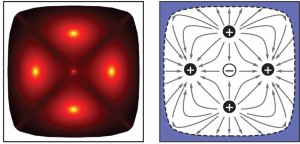
Vortices of bound states in the continuum. The left panel shows five bound states in the continuum in a photonic crystal slab as bright spots. The right panel shows the polarization vector field in the same region as the left panel, revealing five vortices at the locations of the bound states in the continuum. These vortices are characterized with topological charges +1 or -1.
Credit: MIT
Research out of the Massachusetts Institute of Technology has led to a new understanding of how to halt protons, which could lead to miniature particle accelerators and improved data transmission.
Accordingly, this new work could help explain some basic physical mechanisms.
Last year, researchers from MIT succeeded in creating a material that could trap light and stop it in its tracks. Now, the same batch of researchers have conducted more studies in order to develop a more fundamental understand of the process, which reveals that this behavior is connected to a wide range of seemingly unrelated phenomena.
This from MIT:
Light can usually be confined only with mirrors, or with specialized materials such as photonic crystals. Both of these approaches block light beams; last year’s finding demonstrated a new method in which the waves cancel out their own radiation fields. The new work shows that this light-trapping process, which involves twisting the polarization direction of the light, is based on a kind of vortex — the same phenomenon behind everything from tornadoes to water swirling down a drain.
It has also been discovered that the trapped state is much more stable than had been initially thought, making it easier to produce and harder to disturb.
The phenomenon makes it possible to produce what is known as a vector beam – a special kind of laser beam that has the potential to create small-scale particle accelerators.
The research was partly supported by the U.S. Army Research Office through MIT’s Institute for Soldier Nanotechnologies, as well as the Department of Energy and the National Science Foundation.
Want to learn more about the latest scientific and technical developments in materials science and beyond? Make sure to attend the 227th ECS Meeting in Chicago, Illinois!


